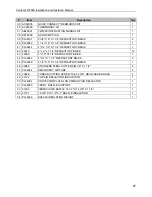
Century FW3300 Installation and Operation Manual
37
Some jurisdictions in the United States require that wood stoves have a supply of
combustion air from outdoors. If you do install an air supply through the wall of the house,
be aware that its pressure can be affected during windy weather. If you notice changes in
wood stove performance in windy weather, and in particular if smoke puffs from the stove,
you should disconnect the outdoor air duct from the stove and remove the duct. In some
windy conditions, negative pressure at the duct weatherhood outside the house wall may
draw hot exhaust gases from the stove backwards through the duct to outdoors. Check the
outdoor air duct for soot deposits when the full system is cleaned and inspected at least
once each year.
8.6
Installing the Chimney Connector
The chimney connector is the single or double wall pipe installed between the stove flue
collar and the chimney breech. Single wall pipe components are available from most
hardware and building supply stores. These components are not usually tested to a
particular standard and certified as compliant. Therefore, a list of rules found in solid fuel
installation codes apply to the installation of single wall pipe.
Double wall chimney connectors are tested and certified. The rules for double wall pipe are
found in the manufacturer’s installation instructions. These rules will be very different than
those for single wall.
8.6.1 Installation of Single Wall Chimney Connector
The chimney connector assembly has been called ‘the weak link’ in the safety of wood
heating systems because failure to install the connector properly (which has been common
in the past) can result in house fires.
The best flue pipe assembly is one that rises straight up from the stove to the base of the
chimney with no elbows. Straight assemblies are less likely to cause problems like smoke
roll-out when the door is opened for loading. They are also more stable and easier to
maintain than assemblies with elbows. Horizontal runs of flue pipe should be avoided
where possible because they reduce chimney draft.












































